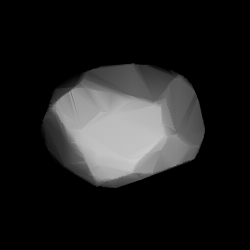 Shape model of Zoya from its lightcurve | |
| Discovery [1] | |
|---|---|
| Discovered by | T. Smirnova |
| Discovery site | Crimean Astrophysical Obs. |
| Discovery date | 28 February 1968 |
| Designations | |
| (1793) Zoya | |
Named after | Zoya Kosmodemyanskaya (Hero of the Soviet Union) [2] |
| 1968 DW ·1932 MC 1933 UV ·1946 TC 1949 QX ·1951 AE 1953 VP2 ·1953 VW1 1953 XF ·1969 RP1 | |
| main-belt · Flora [3] | |
| Orbital characteristics [1] | |
| Epoch 4 September 2017 (JD 2458000.5) | |
| Uncertainty parameter 0 | |
| Observation arc | 83.44 yr (30,475 days) |
| Aphelion | 2.4405 AU |
| Perihelion | 2.0067 AU |
| 2.2236 AU | |
| Eccentricity | 0.0975 |
| 3.32 yr (1,211 days) | |
| 321.35° | |
| Inclination | 1.5088° |
| 225.99° | |
| 323.37° | |
| Physical characteristics | |
| Dimensions | 8.348±0.301 km [4] 9.41 km (calculated) [3] |
| 5.75187±0.00001 h [5] 5.751872±0.000005 h [6] 5.753±0.001 h [7] 7.0 h [8] | |
| 0.24 (assumed) [3] 0.334±0.047 [4] | |
| S [3] | |
| 12.20 [4] ·12.3 [1] [3] ·12.31±0.23 [9] | |
1793 Zoya, provisional designation 1968 DW, is a stony Florian asteroid from the inner regions of the asteroid belt, approximately 9 kilometers in diameter. It was discovered on 28 February 1968, by Russian astronomer Tamara Smirnova at the Crimean Astrophysical Observatory in Nauchnyj, on the Crimean peninsula, and named after World War II partisan Zoya Kosmodemyanskaya. [2] [10]